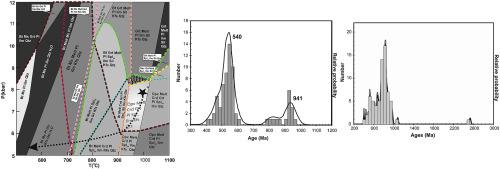Geoscience Frontiers ( IF 8.5 ) Pub Date : 2019-07-19 , DOI: 10.1016/j.gsf.2019.05.013 Nilanjana Sorcar , Kumar Batuk Joshi , Elson P. Oliveira , J.K. Tomson , V. Nandakumar

|
Phase equilibria modelling coupled with U–Pb zircon and monazite ages of garnet–cordierite gneiss from Vallikodu Kottayam in the Kerala Khondalite Belt, southern India are presented here. The results suggest that the area attained peak P–T conditions of ~900 °C at 7.5–8 kbar, followed by decompression to 3.5–5 kbar and cooling to 450–480 °C, preserving signatures of the partial melting event in the field of high to ultra-high temperature metamorphism. Melt reintegration models suggest that up to 35% granitic melt could have been produced during metamorphism at ~950 °C. The U–Pb age data from zircons (~1.0 – ~0.7 Ga) and chemical ages from monazites (~540 Ma and ~941 Ma) reflect a complex tectonometamorphic evolution of the terrain. The ~941 Ma age reported from these monazites indicate a Tonian ultra-high temperature event, linked to juvenile magmatism/deformation episodes reported from the Southern Granulite Terrane and associated fragments in Rodinia, which were subsequently overprinted by the Cambrian (~540 Ma) tectonothermal episode.
中文翻译:

印度喀拉拉邦本田岩带的石榴石-堇青石片麻岩中部分熔融事件的特征
本文介绍了印度南部喀拉拉邦昆达岩带Vallikodu Kottayam的U-Pb锆石和独居石年龄的石榴石-堇青石片麻岩的相平衡模型。结果表明该区域达到了峰值P – T在7.5–8 kbar下约900°C的条件,然后减压至3.5–5 kbar并冷却至450-480°C,保留了从高温到超高温领域的部分熔融事件的特征变质。熔体再整合模型表明,在约950°C的变质过程中可能产生了35%的花岗岩熔体。锆石(〜1.0-〜0.7 Ga)的U–Pb年龄数据和独居石(〜540 Ma和〜941 Ma)的化学年龄数据反映了该地形的复杂构造演化。这些独居石所报告的〜941 Ma年龄表明是一次Tonian超高温事件,与南部Granulite地貌和Rodinia的相关碎片报告的少年岩浆作用/变形事件有关,随后被寒武纪覆盖(〜540 Ma )构造热事件。











































 京公网安备 11010802027423号
京公网安备 11010802027423号